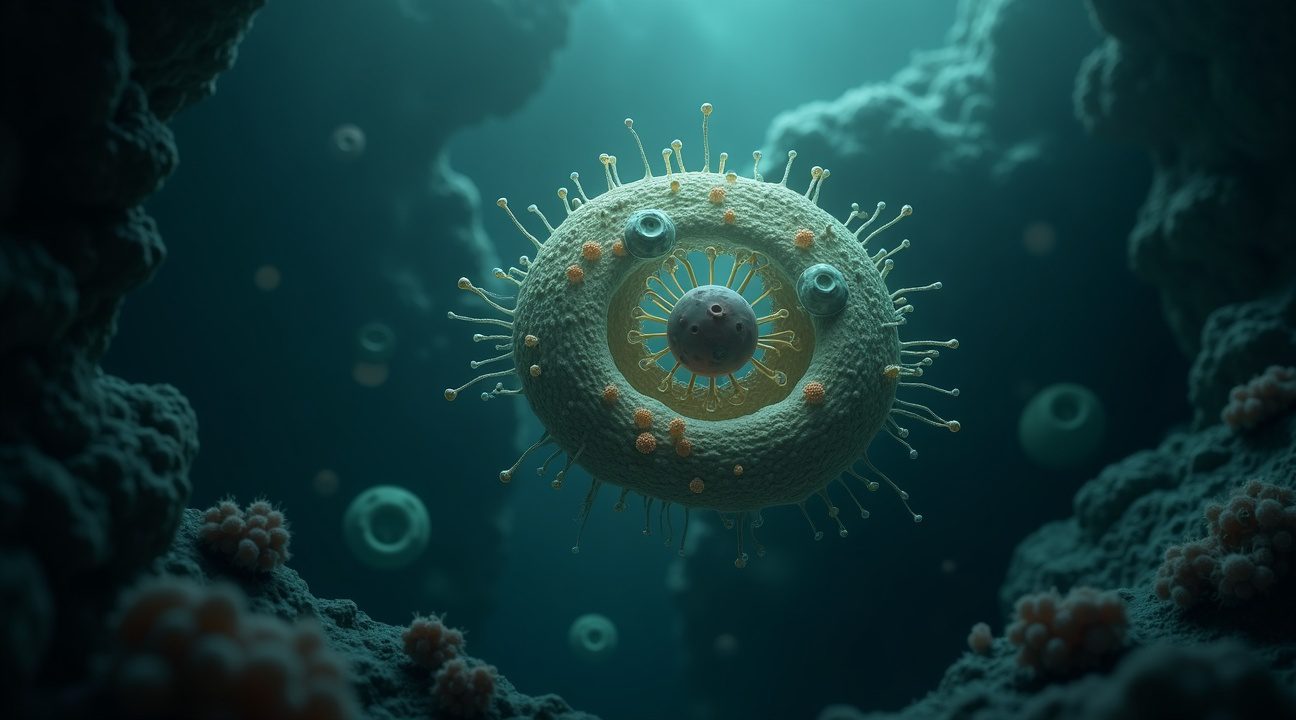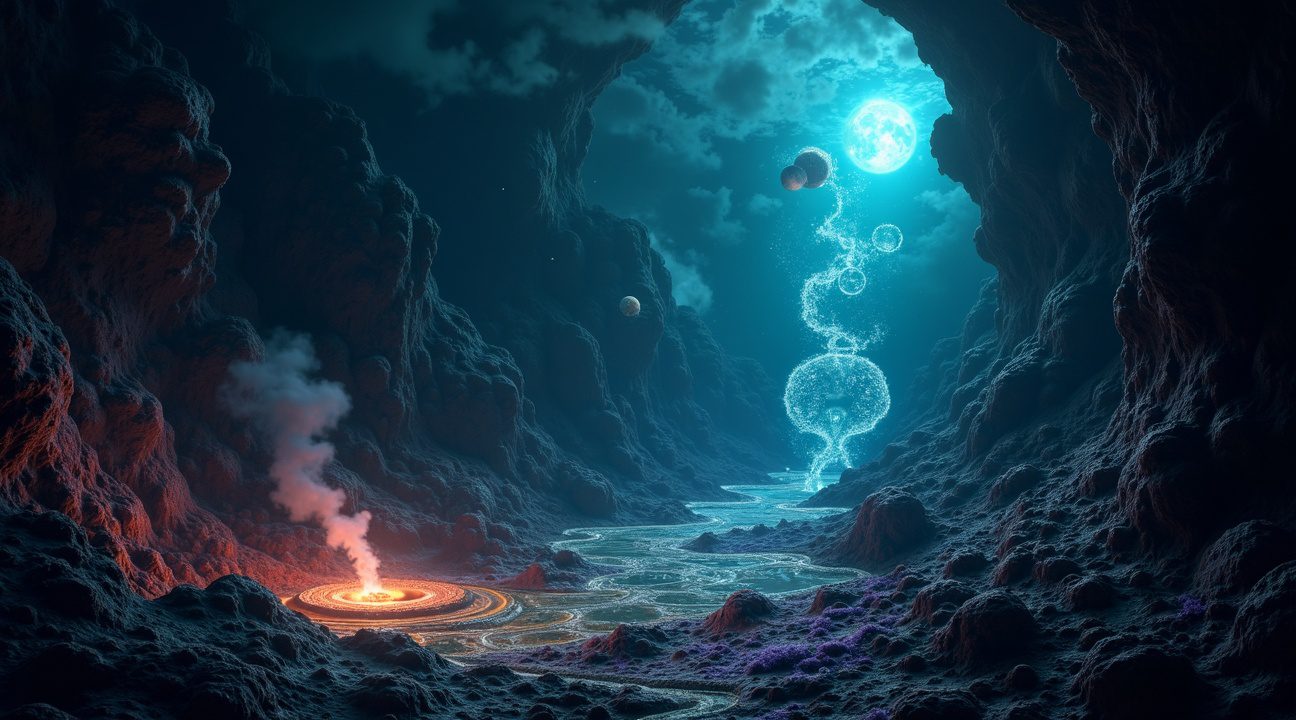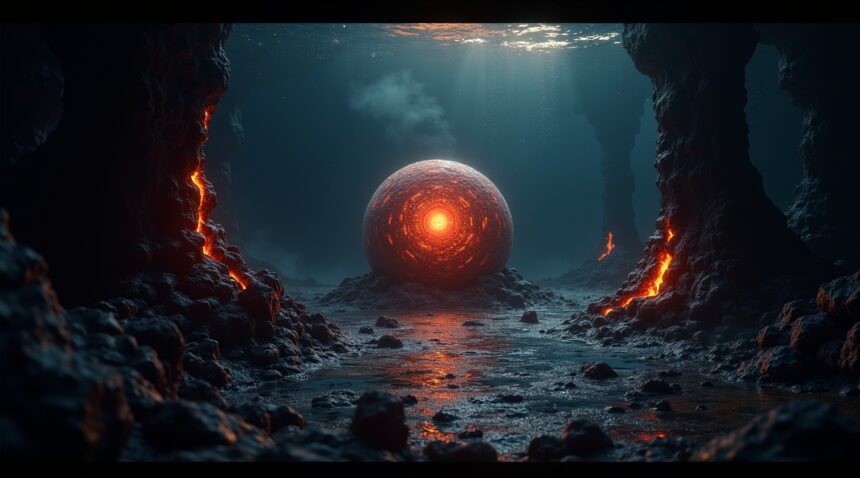Scientists have identified LUCA (Last Universal Common Ancestor) as a sophisticated single-celled organism that lived approximately 4.2 billion years ago and serves as the evolutionary origin point for all life on Earth.
Recent findings from genetic analysis reveal LUCA’s remarkable complexity, including core biological mechanisms that enabled survival in ancient Earth’s extreme environments. LUCA is now central to our understanding of both the origins of life and the potential for life beyond our planet.
Key Takeaways
- LUCA lived approximately 4.2 billion years ago in harsh hydrothermal vent ecosystems, relying on chemosynthesis and iron-sulfur chemistry rather than photosynthesis for energy.
- This ancient organism contained roughly 2,600 protein-coding genes, along with sophisticated biological systems such as ribosomes, DNA repair mechanisms, and CRISPR-Cas defense systems.
- All known life—Bacteria, Archaea, and Eukarya—traces its lineage back to LUCA, highlighting our shared evolutionary heritage through this single ancestral organism.
- LUCA’s existence helps guide astrobiology, offering insights into the types of environments that may host life on other worlds, including oceanic moons like Enceladus and Europa.
- By studying LUCA’s genetic traits, researchers can better differentiate between the universal characteristics of life and those that evolved later, providing breakthroughs in biotechnology and the hunt for extraterrestrial organisms.
The Invisible Ancestor That Changed Everything 4.2 Billion Years Ago
I find it fascinating that every living thing on Earth—from the smallest bacterium to the largest whale—shares a common ancestor that existed over 4 billion years ago. This microscopic organism, known as LUCA (Last Universal Common Ancestor), represents one of biology’s most significant mysteries and discoveries rolled into one.
When Life Took Its Most Important Turn
LUCA lived approximately 4.2 billion years ago, though scientists continue debating the exact timeline with estimates ranging from 3.5 to 4.3 billion years ago or even earlier. To put this in perspective, Earth formed just 4.6 billion years ago, meaning LUCA appeared a mere 400 million years after our planet’s birth. This places LUCA’s existence squarely within the Hadean Eon, a period when Earth endured extreme volcanic activity, asteroid bombardments, and conditions that would be utterly hostile to most life forms we know today.
What makes LUCA particularly remarkable isn’t that it was the first living organism—scientists believe countless other life forms preceded it. Instead, LUCA represents the last common ancestor from which all three domains of cellular life descended:
- Bacteria
- Archaea
- Eukarya
Every cell in your body, every plant in your garden, and every microbe in the soil can trace its lineage back to this single organism through an unbroken chain of reproduction spanning billions of years.
The Genetic Foundation of Everything
LUCA functions as the crucial node in Earth’s genetic tree where the fundamental prokaryotic domains diverged into separate evolutionary paths. I think of it as the biological equivalent of a family tree’s root system, where all branches eventually converge into a single point of origin. This convergence occurred after billions of years of earlier evolution, making LUCA not the beginning of life but rather the beginning of life as we can still recognize it today.
Recent genetic studies have helped scientists piece together what LUCA might have looked like and how it functioned. Unlike the complex organisms we see today, LUCA was likely a simple single-celled organism that possessed the basic genetic machinery necessary for reproduction and survival. It probably lived in extreme environments, possibly near hydrothermal vents or other harsh conditions that characterized early Earth.
The discovery and study of LUCA has profound implications for understanding how life develops and spreads. Scientists studying DNA preservation often look back to these ancient origins to understand genetic stability across vast time periods. Similarly, researchers exploring life’s building blocks in space frequently reference LUCA’s characteristics to identify what conditions might support life elsewhere.
The timeline of LUCA’s existence also highlights how quickly life can establish itself under the right conditions. Within just 400 million years of Earth’s formation—a relatively short period in geological terms—life had not only emerged but had evolved complex enough systems to ensure its continued survival and diversification. This rapid development gives scientists hope when searching for life on other planets and moons, including discoveries of hidden ecosystems in unexpected places on Earth.
Understanding LUCA’s role in life’s history helps explain the fundamental unity underlying all biological diversity. Despite the enormous variety of life forms that exist today, the fact that they all share this common ancestor means they also share basic cellular processes, genetic codes, and biochemical pathways. This shared heritage provides the foundation for comparative biology and helps scientists understand how evolution shapes life across different environments and time scales.
A Surprisingly Complex Single Cell With Modern-Day Sophistication
I find it fascinating that LUCA wasn’t the primitive, simple blob many people imagine when they think about early life. This ancient organism was actually a sophisticated single-celled prokaryote that shared remarkable similarities with today’s bacteria. LUCA possessed a lipid bilayer membrane and circular DNA, fundamental features that continue to define cellular life across the planet.
Genomic Complexity Rivaling Modern Microbes
The genetic blueprint of LUCA reveals a level of complexity that would surprise most people. Scientists estimate that LUCA’s genome contained approximately 2,600–2,657 protein-coding genes and measured about 2.5–2.75 megabases in size. This genomic complexity matches what I see in contemporary prokaryotes, suggesting that even billions of years ago, life had already achieved remarkable organizational sophistication.
Research has identified around 355 core genes that were likely present in LUCA, each serving critical roles in essential metabolic and information-processing functions. These genes formed the foundation for virtually every biological process that sustains life today. LUCA also possessed the universal genetic code and ribosomes for protein synthesis, establishing the basic machinery that all living organisms still use to translate genetic information into functional proteins.
Ancient Defense Systems and Evolutionary Innovation
Perhaps most intriguingly, LUCA likely possessed an early immune system that included CRISPR-Cas genes. These genetic tools allowed this ancient organism to defend itself against primordial viruses, demonstrating that the evolutionary arms race between life and its parasites began at the very dawn of cellular existence. This early immune capability shows that even the earliest common ancestor had developed sophisticated strategies for survival and self-protection.
The complexity I observe in LUCA challenges traditional assumptions about early life forms. Rather than being a simple transitional stage, LUCA represented a fully functional cellular organism with many of the sophisticated systems we associate with modern life. This ancient cell possessed:
- Metabolic pathways
- Genetic machinery
- Defense mechanisms
These components allowed LUCA to thrive in Earth’s early environment while giving rise to the incredible diversity of life we see today. Much like how scientists continue to discover undiscovered species in unexpected places, LUCA’s complexity reveals that sophisticated life emerged much earlier than previously thought.

Life in Earth’s Most Extreme Environments
Deep beneath the ocean floor, where crushing pressure meets scalding temperatures and no sunlight has ever penetrated, LUCA made its home in one of Earth’s most hostile environments. Scientists believe this ancient ancestor flourished in hydrothermal vents, where iron and sulfur-rich waters created a chemical soup that would prove lethal to most modern life forms.
Surviving Without Oxygen
LUCA operated as a strict anaerobe, thriving in environments completely devoid of oxygen. This adaptation wasn’t just beneficial—it was essential for survival on early Earth, where oxygen remained virtually absent from the atmosphere. It is fascinating that this ancestor developed sophisticated survival mechanisms in conditions that would instantly kill most contemporary organisms.
The organism’s autotrophic nature allowed it to synthesize its own nutrients from the basic chemicals available in its surroundings. Rather than relying on other organisms for sustenance, LUCA crafted its meals from simple inorganic compounds floating in the superheated waters around hydrothermal vents. This self-sufficiency proved crucial for establishing life in an environment where no other living things existed.
Chemical Innovation and Energy Pathways
LUCA’s metabolic toolkit included several key ingredients that scientists have identified through genetic analysis. The organism likely processed hydrogen, carbon dioxide, and nitrogen to fuel its biological processes. These three gases, abundant around volcanic vents, provided the raw materials necessary for sustaining life in such extreme conditions.
The Wood-Ljungdahl Pathway represents one of LUCA’s most significant innovations. This metabolic route enabled acetogenic growth while facilitating carbon fixation—essentially allowing the organism to capture carbon from its environment and incorporate it into vital biological molecules. Modern extremophiles still use variations of this pathway, demonstrating its effectiveness across billions of years of evolution.
Iron-sulfur chemistry played a central role in LUCA’s energy production systems. These mineral clusters served as electron carriers, enabling the transfer of energy throughout the organism’s cellular machinery. The abundance of iron and sulfur compounds around hydrothermal vents provided an endless supply of these crucial components.
Heat tolerance became another defining characteristic of LUCA’s survival strategy. While most proteins denature at high temperatures, LUCA developed heat-stable molecular machinery capable of functioning in waters that could reach several hundred degrees Celsius. This adaptation allowed the organism to tap into energy sources unavailable to heat-sensitive life forms.
The dark, high-pressure environment of deep-sea vents shaped LUCA’s entire approach to survival. Without access to solar energy, the organism developed chemosynthetic processes that extracted energy from chemical reactions instead of photosynthesis. This independence from sunlight opened up vast underground habitats that remain largely unexplored today.
Hydrogen metabolism became a cornerstone of LUCA’s energy system. The organism could harness energy from hydrogen gas reactions, converting simple molecules into complex organic compounds necessary for growth and reproduction. This capability provided a reliable energy source in an environment where traditional food chains didn’t exist.
Modern extremophiles discovered in remote underground environments continue to use similar strategies, suggesting that LUCA’s innovations remain viable after billions of years. Scientists studying these organisms gain insights into how life might develop on other planets with similarly extreme conditions.
The legacy of LUCA’s extremophile lifestyle persists in organisms that inhabit some of Earth’s most challenging environments today. From deep-sea thermal vents to underground caves, life continues to thrive using metabolic pathways that trace back to this universal ancestor. Understanding these ancient survival mechanisms helps researchers explore possibilities for life beyond Earth, particularly in environments that mirror the conditions where LUCA first emerged.

The Genesis of All Life’s Family Tree
LUCA established the fundamental genetic blueprint that would eventually branch into every living organism on Earth. This ancient microbe possessed the essential molecular machinery that enabled all subsequent life to emerge through evolutionary divergence. The genetic material within LUCA contained the core instructions necessary for cellular function, metabolism, and reproduction that continue to define biological systems today.
The Three-Way Split That Shaped Life
From LUCA’s foundation emerged the three domains of life that scientists recognize today: Bacteria, Archaea, and Eukarya. Each domain developed distinct characteristics while retaining fundamental similarities traceable back to their common ancestor. Bacteria evolved into the diverse prokaryotic organisms that dominate many environments, while Archaea adapted to extreme conditions and developed unique biochemical pathways. Eukarya, which includes all plants, animals, and fungi, developed complex cellular structures with membrane-bound organelles.
This evolutionary divergence occurred through gradual changes in genetic material over billions of years. LUCA’s descendants adapted to different environmental niches, developing specialized traits that allowed them to thrive in various conditions. The process wasn’t linear or isolated—early microbes engaged in extensive genetic exchange that accelerated their evolutionary development.
Ancient Ecosystems and Genetic Exchange
LUCA didn’t exist in isolation but functioned within a complex microbial ecosystem alongside other early life forms. Scientists believe these ancient communities included methanogens and other microbes that participated in sophisticated nutrient recycling processes. These interactions created the first biological networks where different organisms depended on each other for survival and growth.
The ecosystem dynamics surrounding LUCA facilitated extensive horizontal gene transfer, a process where organisms directly exchange genetic material rather than passing it only to offspring. This genetic sharing mechanism allowed beneficial traits to spread rapidly throughout early microbial communities. Through horizontal gene transfer, genes originally present in LUCA became widely distributed and modified across different lineages.
Over billions of years, this genetic exchange has continued to shape life’s diversity. Modern organisms still carry traces of LUCA’s original genetic material, though it has been altered through countless evolutionary processes. Some genes have been duplicated, modified, or combined with genetic material from other sources, creating the complex genomes observed in contemporary species.
The discovery that essential building blocks for life can form in various environments supports the idea that LUCA-like organisms could potentially emerge elsewhere in the universe. Understanding LUCA’s characteristics helps scientists identify what features might be universal requirements for life, whether on Earth or in distant environments. This ancient ancestor’s legacy continues to influence every biological process, from the simplest bacterial metabolism to the complex cellular functions that sustain all higher life forms.
Why Scientists Are Racing to Understand Our Universal Parent
Finding LUCA offers scientists a crucial window into life’s earliest chapters on Earth. I can see why researchers across multiple disciplines have made this ancient organism their primary focus—understanding LUCA’s characteristics provides invaluable insights into how life first emerged from non-living matter billions of years ago.
Phylogenetics plays a central role in this scientific pursuit. By comparing genetic sequences across all three domains of life—bacteria, archaea, and eukarya—researchers can work backward through evolutionary time to reconstruct what LUCA might have looked like. This genetic detective work reveals which traits were already present in our universal ancestor and which evolved later.
The implications extend far beyond Earth’s history. Scientists have discovered that environments similar to those where LUCA likely thrived still exist today, both on our planet and potentially elsewhere in the solar system. Hydrothermal vents, with their unique chemistry and energy sources, mirror the conditions that may have supported our earliest ancestor. These deep-sea environments showcase how life can flourish in extreme conditions without sunlight, using chemical energy instead.
Expanding the Search Beyond Earth
Astrobiology researchers have identified several locations where similar hydrothermal systems might exist. Saturn’s moon Enceladus harbors subsurface oceans with active hydrothermal venting, creating conditions remarkably similar to early Earth. Europa, Jupiter’s ice-covered moon, also shows evidence of underwater thermal activity that could support life forms resembling LUCA.
Understanding LUCA’s metabolism and environmental preferences helps scientists know what to look for in their search for extraterrestrial life. If life beyond Earth follows similar patterns to our universal ancestor, it might rely on chemosynthesis rather than photosynthesis, deriving energy from chemical reactions in rocky environments. This knowledge shapes how space missions are designed and what instruments they carry.
The race to characterize LUCA also drives technological advancement in genetic analysis and computational biology. Each new discovery about our universal parent refines our understanding of life’s fundamental requirements and constraints. Scientists can then apply these insights to assess the habitability of exoplanets and moons throughout the galaxy.
LUCA research directly informs the search for life by establishing baseline characteristics that all Earth life shares. This genetic foundation helps researchers distinguish between universal features of life and those that evolved later through specific environmental pressures. The more scientists learn about our universal ancestor, the better equipped they become to recognize life in forms that might differ significantly from modern organisms.

What LUCA Reveals About Life’s Incredible Journey
LUCA represents far more than a scientific curiosity—it’s the pivotal point where all life on Earth converges. Every organism you see today, from the smallest bacteria to the largest whales, traces its lineage back to this single ancestral entity that lived approximately 3.5 to 3.8 billion years ago. Phylogenetic studies have provided compelling genetic evidence that confirms this remarkable connection, making LUCA one of the most significant discoveries in evolutionary biology.
Unlike earlier theoretical life forms such as FUCA (First Universal Common Ancestor), LUCA benefits from substantial scientific backing through comprehensive genetic analysis. Researchers can identify LUCA’s characteristics by examining genes shared across all domains of life—bacteria, archaea, and eukaryotes. This genetic evidence reveals that LUCA possessed a sophisticated cellular machinery, including ribosomes for protein synthesis and a genetic code that remains virtually unchanged across billions of years of evolution.
LUCA’s Connection to Astrobiology and Life Beyond Earth
The study of LUCA has profound implications for astrobiology and our search for life throughout the universe. Scientists believe LUCA likely inhabited hydrothermal vents on the ocean floor, where chemical energy from Earth’s interior provided the fuel for early life processes. This discovery has directed astrobiologists to focus their attention on similar environments on other worlds, particularly the icy moons of Saturn where hydrothermal activity might exist beneath frozen surfaces.
LUCA’s gene-based systems offer crucial insights for identifying potential life on other planets. The universal genetic code that emerged from LUCA suggests that certain biochemical solutions to life’s challenges might be inevitable, regardless of where life develops. This understanding helps scientists design detection methods that look for similar molecular signatures in extraterrestrial environments. The research also suggests that if life exists elsewhere, it might share fundamental characteristics with Earth’s organisms, making it easier to recognize and study.
The evolutionary history revealed through LUCA research demonstrates life’s incredible adaptability and resilience. LUCA survived in extreme conditions that would be lethal to most modern organisms, yet it possessed the genetic flexibility to eventually give rise to the extraordinary diversity we see today. This adaptability suggests that life might be more common in the universe than previously thought, capable of thriving in environments that seem hostile by current standards.
Modern genetic analysis techniques continue to refine our understanding of LUCA’s characteristics and capabilities. Scientists can now identify which genes were likely present in LUCA by comparing genomes across different species and identifying shared components. This approach has revealed that LUCA was already a sophisticated organism with complex metabolic pathways, DNA repair mechanisms, and cellular structures—indicating that simpler life forms preceded it.
The implications extend beyond academic interest into practical applications for biotechnology and medicine. Understanding LUCA’s fundamental biological processes helps researchers identify core cellular functions that remain consistent across all life forms. This knowledge proves invaluable for developing treatments that target essential cellular processes shared by all organisms, including disease-causing bacteria and viruses.
LUCA’s story also connects to ongoing discoveries about undiscovered species in extreme environments on Earth. These discoveries often reveal organisms with characteristics that might resemble LUCA’s descendants, providing living examples of how early life might have functioned and evolved. Each new species discovered in extreme environments adds another piece to the puzzle of life’s early history.
The cellular life that emerged from LUCA demonstrates the power of evolutionary innovation over vast timescales. From LUCA’s relatively simple beginning emerged photosynthesis, multicellularity, complex tissues, and eventually consciousness itself. This progression shows how small genetic changes, accumulated over billions of years, can produce results that seem almost miraculous in their complexity and sophistication. The universal common ancestor thus serves as both the starting point for this incredible journey and proof of evolution’s creative potential.

Sources:
Popular Mechanics: “Last Universal Common Ancestor (LUCA) Is Older Than We Thought”
Wikipedia: “Last universal common ancestor”
NASA Astrobiology: “Looking for LUCA, the Last Universal Common Ancestor”
Nature Ecology & Evolution: “The nature of the last universal common ancestor and its impact on …”
PMC: “The last universal common ancestor between ancient Earth … – PMC”
Quanta Magazine: “All Life on Earth Today Descended From a Single Cell. Meet LUCA.”
ICR: “Evolution’s Hypothetical Last Universal Common Ancestor”
Imperial College News: “Who or what is LUCA?”


